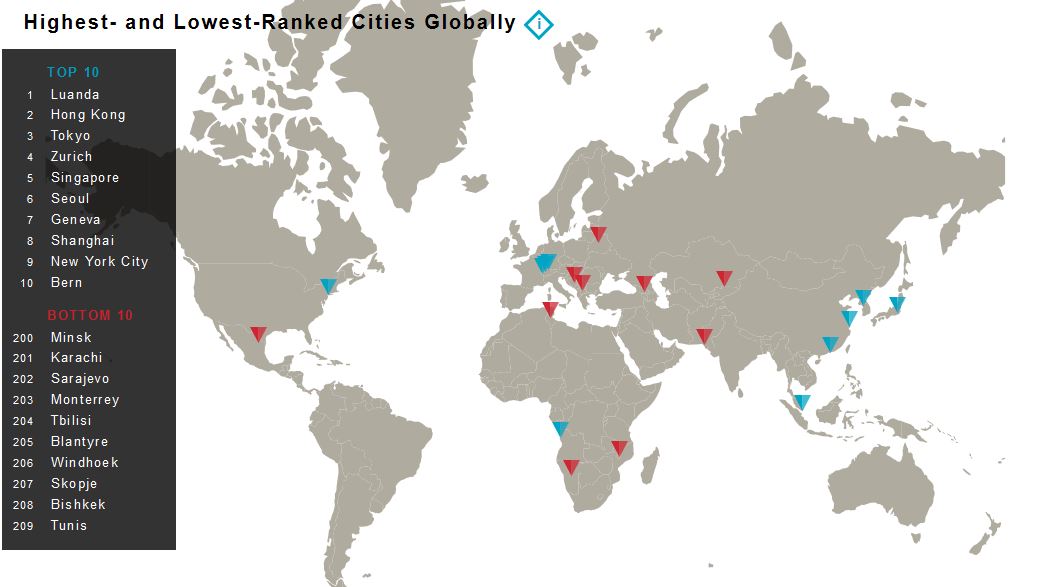Five of the 10 costliest places in the world for expatriates are in Asia-Pacific, a new survey from Mercer showed, and Bangkok (67) jumped seven places from last year.
With its dollar-pegged economy, Hong Kong remains the most expensive city in the region for workers abroad, second worldwide, according to the 23rd Cost of Living Survey by the health, wealth and career consultancy.
Five of the top 10 cities in this year’s ranking are in Asia.
Hong Kong (2) is the most expensive city as a result of its currency pegged to the US dollar, which drove up the cost of accommodations locally. This global financial center is followed by Tokyo (3), Singapore (5), Seoul (6), and Shanghai (8).
“The strengthening of the Japanese yen along with the high costs of expatriate consumer goods and a dynamic housing market pushed Japanese cities up in the ranking,” said Ms. Constantin-Métral.
“However, the majority of Chinese cities fell in the ranking due to the weakening of the Chinese yuan against the US dollar.”
Australian cities have all experienced further jumps up the global ranking since last year due to the strengthening of the Australian dollar.
Sydney (25), Australia’s most expensive city for expatriates, gained seventeen places in the ranking along with Melbourne (46) and Perth (50) which went up twenty-five and nineteen spots, respectively.
Bangkok jumped seven places from last year to 67th
Elsewhere in Asia, Bangkok (67) jumped seven places from last year. Jakarta (88) and Hanoi (100) also rose in the ranking, up five and six places, respectively. Karachi (201) and Bishkek (208) remain the region’s least expensive cities for expatriates.
India’s most expensive city, Mumbai (57), climbed twenty-five places and is now for the first time ahead of Bangkok for cost of living abroad.
Mercer surveyed the cost of more than 200 items, including housing and household goods, in 209 cities around the world.
Shanghai fell from seventh place to eighth in this year’s ranking, while Beijing, Tianjin and Shenzhen occupies the 11th to 13th notches. “The majority of Chinese cities fell in the ranking due to the weakening of the Chinese yuan against the US dollar.
India’s most expensive city, Mumbai (57), climbed twenty-five places in the ranking due to its rapid economic growth, inflation on the goods and services basket and a stable currency against the US Dollar.
This most populous city in India is followed by New Delhi (99) and Chennai (135) which rose in the ranking by thirty-one and twenty-three spots, respectively. Bengaluru (166) and Kolkata (184), the least expensive Indian cities, climbed in the ranking as well.
Europe, the Middle East, and Africa
Only three European cities remain in the top 10 list of most expensive cities for expatriates.
Zurich (4) is still the most costly European city on the list, followed by Geneva (7) and Bern (10). Moscow (14) and St. Petersburg (36) surged fifty-three and one hundred and sixteen places from last year respectively, due to the strong appreciation of the ruble against the US dollar and the cost of goods and services.
Meanwhile, London (30), Aberdeen (146) and Birmingham (147) dropped thirteen, sixty-one and fifty-one spots respectively as a result of the pound weakening against the US dollar following the Brexit vote.
Copenhagen (28) fell four places from 24 to 28. Oslo (46) is up thirteen spots from last year, while Paris fell eighteen places to rank 62.
Other Western European cities dropped in the rankings as well, mainly due to the weakening of local currencies against the US dollar. Vienna (78) and Rome (80) fell in the ranking by 24 and 22 spots, respectively. The German cities of Munich (98), Frankfurt (117), and Berlin (120) dropped significantly as did Dusseldorf (122) and Hamburg (125).
“Despite moderate price increases in most of the European cities, European currencies have weakened against the US dollar, which pushed most Western European cities down in the ranking,” explained Ms. Constantin-Métral.
“Additionally, other factors like the Eurozone’s economy have impacted these cities.”
As a result of local currencies depreciating against the US dollar, some cities in Eastern and Central Europe, including Prague (132) and Budapest (176) fell in the ranking, while Minsk (200) and Kiev (163) jumped four and thirteen spots, respectively, despite stable accommodations in these locations.
Ranking 17, Tel Aviv jumped two spots from last year and continues to be the most expensive city in the Middle East for expatriates followed by Dubai (20), Abu Dhabi (23), and Riyadh (52), which have all climbed in this year’s ranking. Jeddah (117), Muscat (92), and Doha (81) are among the least expensive cities in the region. Cairo (183) is the least expensive city in the region plummeting ninety-two spots from last year following a major devaluation of its local currency.
“Egypt’s decision to allow its currency to float freely in return for a 12 billion dollar loan over three years to help strengthen its economy resulted in the massive devaluation of the Egyptian Pound by more than 100% against the US dollar, pushing Cairo down the ranking” said Ms. Constantin-Métral.”
Quite a few African cities continue to rank high in this year’s survey, reflecting high living costs and prices of goods for expatriate employees. Luanda (1) takes the top spot as the most expensive city for expatriates across Africa and globally despite its currency weakening against the US dollar. Luanda is followed by Victoria (14), Ndjamena (16), and Kinshasa (18). Tunis falls six spots to rank 209 as the least expensive city in the region and overall.




